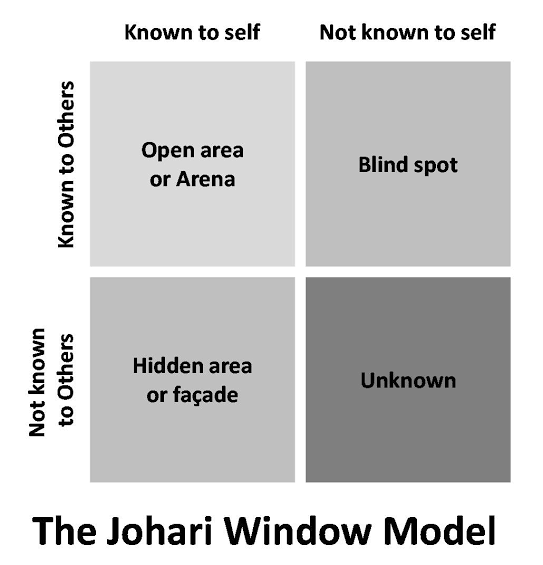Table of Contents
Johari Window
This article is about the cognitive (perceptive or mental faculty of knowing) Psychology tool. For the Fringe episode, see “Johari Window”(Fringe).


The “Johari Window” is a technique that helps peoples better understand their relationship with themselves and others. It was created by psychologists “Joseph Luft”(1916-2014) and “Harrington Ingham” (1916-1995) in 1995 and is used primarily in self-help groups and corporate settings as a heuristic( enabling one to find out things for one or themselves) exercise. Luft and Ingham named their model “Johari” using a combination of their first names.
Description
In the exercise, subjects, pick a number of adjectives from a list, choosing ones they feel describe their own personality. The subject’s peers then get the same list, and each picks an equal number of adjectives that describes the subject. These adjectives are then inserted into a two-by-two grid of four cells.
The philosopher “Charles Handy” calls this concept the “Johari House” with four rooms. Room one is the part of ourselves that we and others see. Room two contains aspects that others see but we are unaware of. Room three is the private space we know but hide from others. Room four is the unconscious part of us that neither ourselves nor others see.
The Four Quadrants
1. Open, or Arena
Adjectives that both the subject (a member of state) and peers (noble person) select to go in this cell (or quadrant) of the grid. These are traits that subject and peers perceive.
2. Hidden, or Facade
Adjectives selected by the subject, but not by any of their peers, go in this quadrant. These are things the peers are either unaware of, or that are untrue but for the subject’s claim.
3. Blind Spot
Adjectives not selected by subjects, but only by their peers go here. These requirements what others perceive but the subject does not.
4. Unknown
Adjectives that neither subject nor peers selected go here. They represent the subject’s behaviors or motives that no one participating recognizes–either because they do not apply or because of collective ignorance of these traits.
Following are the “Johari Adjectives”:
A “Johari Window” uses the following “56” adjectives as possible descriptions of the participant.
- Able
- Accepting
- Adaptable
- Bold
- Brave
- Calm
- Caring
- Cheerful
- Clever
- Complex
- Confident
- Dependable
- Dignified
- Empathetic (used for stressing)
- Energetic
- Extroverted (sociable person)
- Friendly
- Giving
- Happy
- Helpful
- Idealistic
- Independent
- Ingenious (frank, artless)
- Intelligent
- Introverted
- Kind
- Knowledgeable
- Logical
- Loving
- Mature
- Modest
- Nervous
- Observant
- Organized
- Patient
- Powerful
- Proud
- Quiet
- Reflective
- Relaxed
- Religious
- Responsive
- Searching
- Self-assertive (interested mainly in oneself)
- Self-conscious
- Sensible Sensible
- Sentimental
- Shy
- Silly
- Spontaneous
- Sympathetic
- Tense
- Trustworthy
- Warm
- Wise
- Witty


Paula Kelly
January 10, 2022 at 9:55 pmNadia is calm, independent, caring, intelligent, kind, organised and trustworthy
Akash Singh
February 6, 2022 at 1:20 pmSonit is calm, accepting, dignified, friendly, helpful,kind, knowledgeable,mature,observant, organized, reflecting,shy , trustworthy,warm